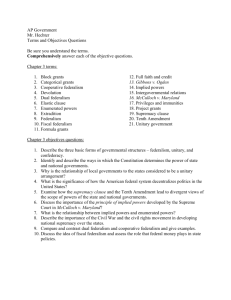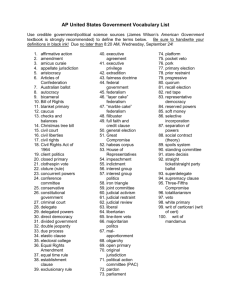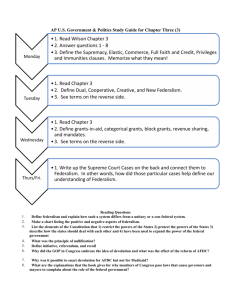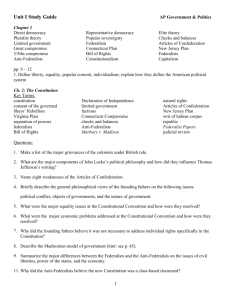Chapter 3 Study Guide – Federalism Pgs. 71
advertisement
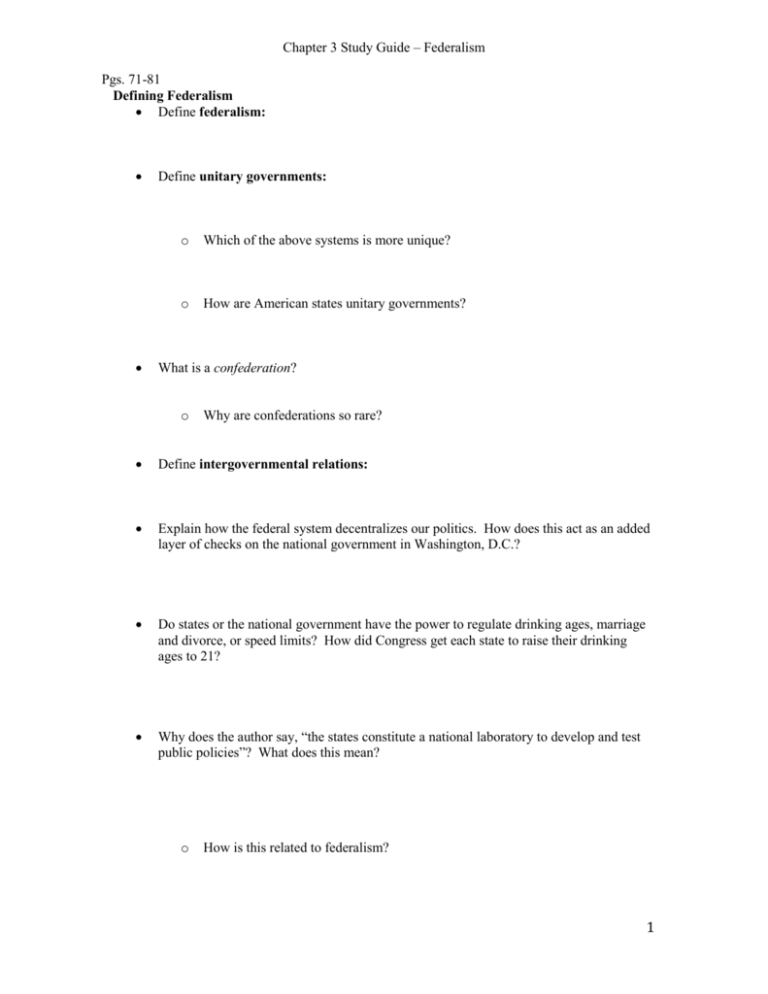
Chapter 3 Study Guide – Federalism Pgs. 71-81 Defining Federalism Define federalism: Define unitary governments: o Which of the above systems is more unique? o How are American states unitary governments? What is a confederation? o Why are confederations so rare? Define intergovernmental relations: Explain how the federal system decentralizes our politics. How does this act as an added layer of checks on the national government in Washington, D.C.? Do states or the national government have the power to regulate drinking ages, marriage and divorce, or speed limits? How did Congress get each state to raise their drinking ages to 21? Why does the author say, “the states constitute a national laboratory to develop and test public policies”? What does this mean? o How is this related to federalism? 1 The Constitutional Basis of Federalism Examine Table 3.2 on page 76. o Identify 3 powers granted to the national government (enumerated/ delegated/express powers): o Identify 3 powers granted to the state governments (reserved powers): o Identify 3 powers granted to both the national and the state governments (concurrent powers): Define supremacy clause: o Define Tenth Amendment: o What would happen if a state law conflicted with a national law? What does this mean for states’ rights? Why is the Supreme Court case McCulloch v. Maryland (1819) significant? o According to the ruling in this case, when there is a conflict between powers of the national government and state powers, which takes precedence? This ruling was derived from what clause of the Constitution? o Why did the Supreme Court rule in favor of the Bank of the United States, even though the Constitution does not explicitly say that Congress has the power to create such a bank? Define enumerated powers: Define implied powers: 2 Define elastic clause: o How is the elastic clause related to implied powers? In the Constitution, who is given the power to regulate interstate and international commerce (the commerce clause)? Why is the Supreme Court case Gibbons v. Ogden (1824) significant? How was the commerce clause used to prohibit racial discrimination in 1964? What was the ruling in United States v. Lopez? o Did this limit or expand Congress’ commerce clause powers? What was the ruling in United States v. Morrison? o Did this limit or expand Congress’ commerce clause powers? How is the Civil War related to the principle of federalism? How is the struggle for racial equality related to the principle of federalism? Define Full Faith and Credit clause: o Identify a few examples of things that would be protected by this clause: o How is same-sex marriage related to the full faith and credit clause? 3 o In your opinion, is the Defense of Marriage Act (DOMA) a violation of the Constitution, specifically the full faith and credit clause? Define extradition: Define privileges and immunities: o What is the goal of this constitutional provision? o What is an exception to the privileges and immunities clause? Pgs. 82-90 Intergovernmental Relations Today Define dual federalism: o What are a few examples of dual federalism in practice? o According to the author, what type of cake is this similar to? Why? Define cooperative federalism: o What are a few examples of cooperative federalism in practice? o According to the author, what type of cake is this similar to? Why? Explain why it is so difficult to definitively characterize the American system as either dual or cooperative federalism: o Which one (dual or cooperative federalism) have we been moving toward more in recent years? How are highways an example of this? What 3 standard operating procedures does cooperative federalism rest on? o o 4 o Define devolution: o What US President began the devolution movement? What political party supported the devolution revolution? o How did the Republicans’ approach to national power since the mid-1990s contradict their stand on devolution? What did many of their programs actually do for the power of the national government? Define fiscal federalism: o According to this system of federalism, what is the national government’s “powerful source of influence over the states”? o Explain what information is portrayed in Figure 3.1 and the significance of this data: Define categorical grants: o How does the national government use such grants to regulate what states do? o What is a crossover sanction? What is an example of this? o What are crosscutting requirements? What is an example of this? Define project grants: o What is an example of a string attached to a grant that forces states to do something that the national government wants them to do? What is an example of this? Define formula grants: 5 o What is an example of this? Define block grants: o What sorts of programs tend to be supported by block grants? o How are block grants different from categorical grants? Which has fewer “strings” attached? What are mandates? o Why do states sometimes object to certain mandates? o How does Medicaid put states in a difficult situation? o What do you think is an unfunded mandate? o What are some examples of unfunded mandates? Why do states dislike unfunded mandates? Explain how national housing regulations lead to problems as a result of unfunded or underfunded mandates: Pgs. 90-96 Understanding Federalism How does federalism increase opportunities for participation? How does federalism increase access to government and the responsiveness of government? How does federalism lead to representation of “a pluralism of interests”, which James Madison valued in a large republic? How can federalism promote peace and stability, in terms of elections? How does it help to cultivate new leaders? 6 How can federalism lead to different policies in different states? o How can this policy innovation at the state level help the national government to adopt new policies? How does federalism reduce decision-making and conflict at the national level? Explain the drawbacks of federalism for democracy: Explain what information is portrayed in Figure 3.2 and the significance of this data: Answer questions 1-14 on pages 96-97 without using the book or your notes. 1. __________ 2. __________ 3. __________ 4. __________ 5. __________ 6. __________ 7. __________ 8. __________ 9. __________ 10. __________ 11. __________ 12. __________ 13. __________ 14. __________ 7
